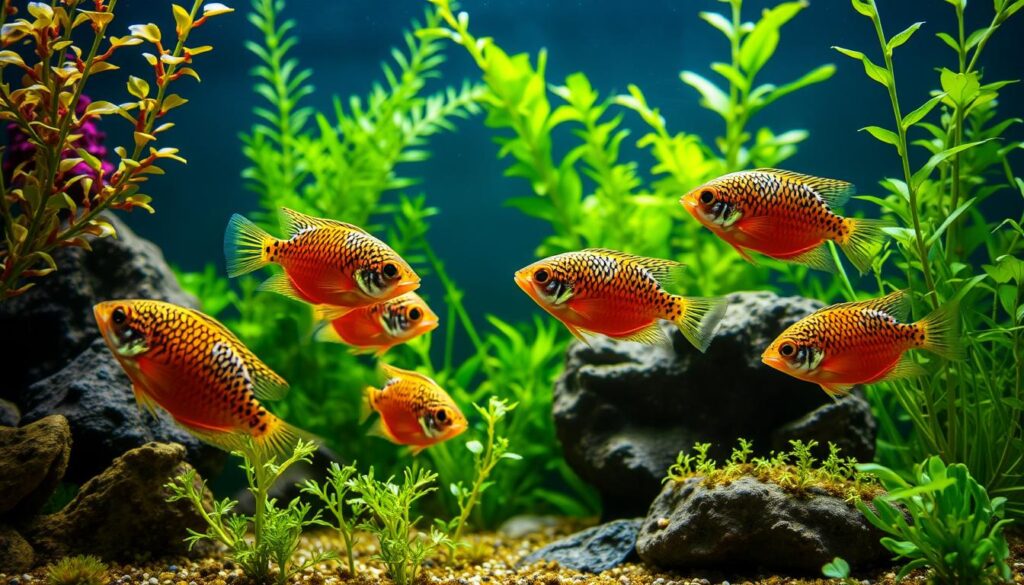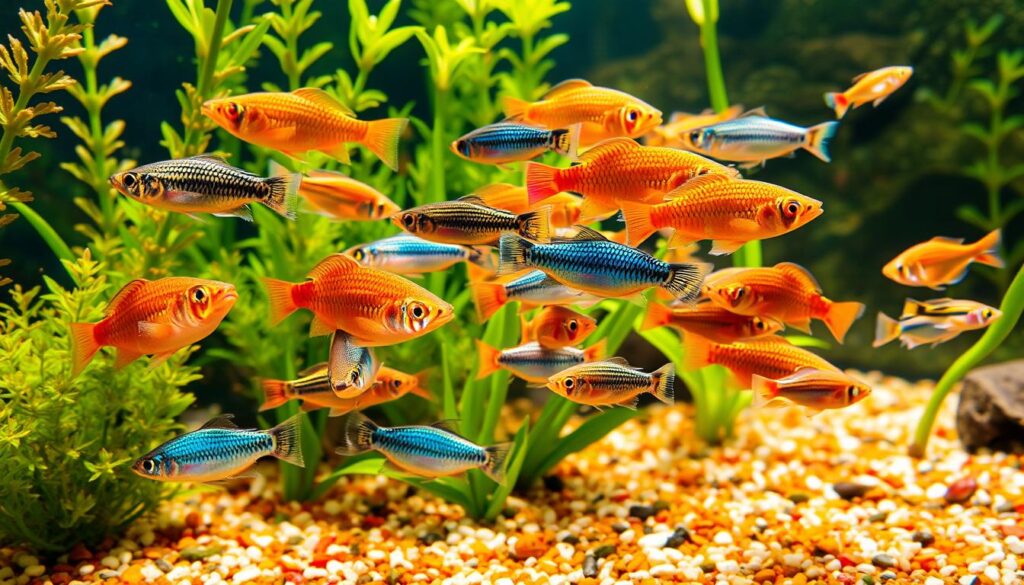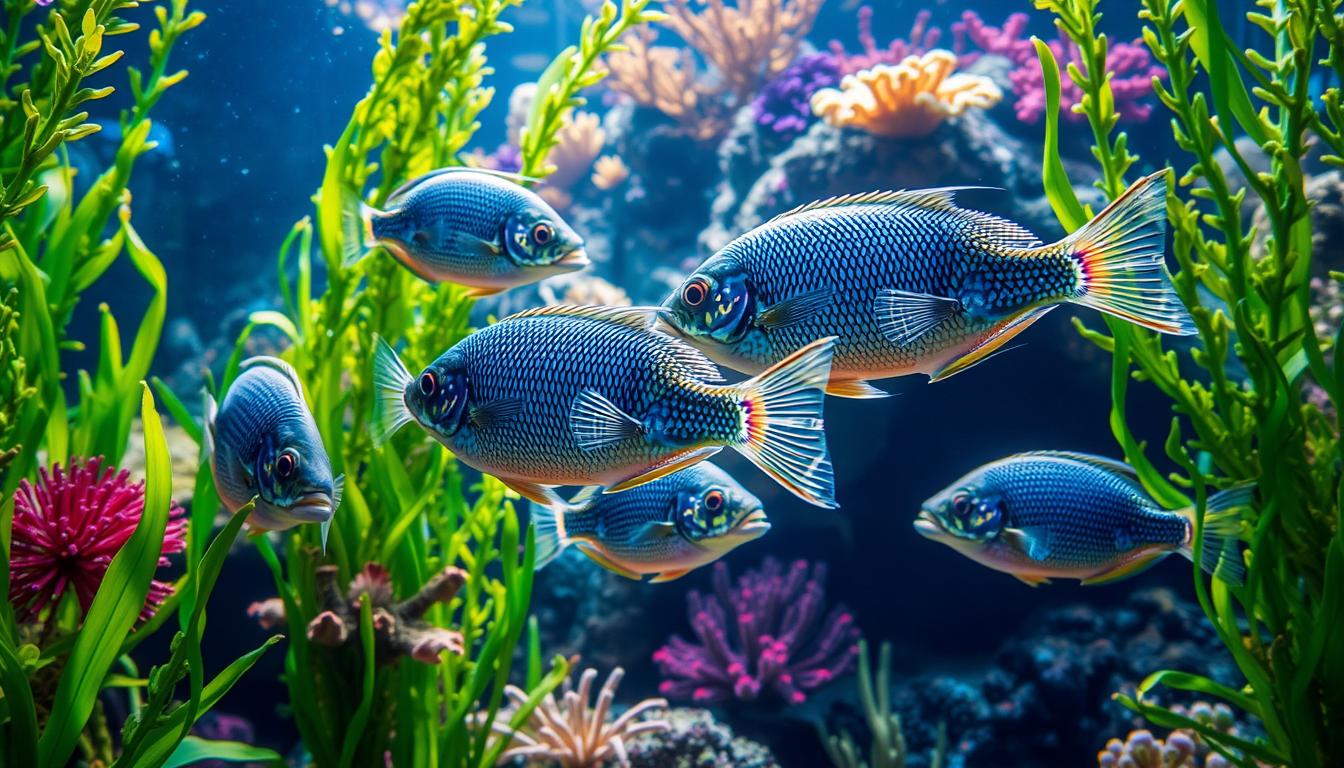Are you ready to explore the world of Endler’s Livebearer Guppies (Poecilia wingei)? These small, colorful fish are a favorite among aquarium fans. They offer a mix of stunning looks and simple care. But what makes Endlers different from regular guppies?
Endler’s Livebearers come from Venezuela’s small coastal streams. They are closely related to guppies but are their own species. These tiny fish grow up to 1-2 inches and are great for small spaces. With their beautiful patterns and a 2-3 year lifespan, they’re perfect for your home aquarium.
Table of Contents
Understanding Endler’s Livebearer Origins and History
Endler’s Livebearers, also known as Poecilia wingei, are colorful fish that have won the hearts of many. They come from the northeastern part of Venezuela, near the Paria Peninsula’s Laguna de Patos. This area is a warm, shallow, and slightly salty lagoon full of plants.
Natural Habitat in Venezuela
In the Laguna de Patos, Endler’s Livebearers live well. They love the warm, slightly salty water and the lots of plants. This place is perfect for these guppy relatives to grow and show off their beautiful colorful fish looks.
Discovery and Introduction to the Aquarium Trade
Franklyn F. Bond, a British naturalist, found Endler’s Livebearer in 1937. But it wasn’t until the 1970s that they became popular in aquariums. John Endler, a famous ichthyologist, introduced them to the trade.
Scientific Classification
Scientifically, they are known as Poecilia wingei. They are close to guppies (Poecilia reticulata) and can even mix with them. This makes them a great choice for anyone who loves tropical fish.
Physical Characteristics and Appearance
Endler’s Livebearers are known for their colorful looks. They are a favorite among freshwater fish fans. These guppy relatives are small, but their bright colors and patterns are stunning.
Males show off neon shades like oranges, greens, blues, and blacks. They use these colors to attract mates. Females are bigger and less colorful, often silver or gray. Males also have special fins for reproduction.
Endler’s Livebearers have a sleek body shape. This helps them move easily in their natural habitats. They are perfect for those who want a colorful, easy-to-care-for fish for their tank.
| Characteristic | Description |
|---|---|
| Size | Rarely exceeding 1.5 inches in length |
| Male Coloration | Vibrant hues of orange, green, blue, and black in intricate patterns |
| Female Coloration | More subdued, typically silver or gray |
| Body Shape | Compact and streamlined |
| Sexual Dimorphism | Males have modified anal fins for reproduction |
Essential Tank Setup for Endler Fish
Keeping your aquarium fish happy and healthy starts with the right tank setup. For Endler fish, a 10-gallon tank is best for 6 to 8 fish. It’s good to have 3 females for every 1 male to keep the peace.
Tank Size and Equipment Requirements
Endler fish do well in tanks that are not too big but not too small. A sponge filter or HOB filter works great because it has a gentle flow. Use fine sand or small gravel for the bottom, like their natural home.
They need about 8-10 hours of light a day. This helps them feel like it’s daytime.
Water Parameters and Temperature
Endler fish like water that’s a bit alkaline, with a pH of 7.0 to 8.5. The water hardness should be between 15 and 35 dGH. Keep the tank’s temperature between 75°F and 86°F (23°C to 30°C).
It’s important to cycle the tank for 4-6 weeks before adding the Endlers. This makes sure the water is stable, with no ammonia or nitrites and nitrates below 20 ppm.
Ideal Plant Selection and Decorations
- Use lots of live plants like water lettuce, Java moss, and Anubias to make the tank look natural and lush.
- Add hiding spots and visual breaks with driftwood, rocks, and other decorations. This makes the tank more comfortable for the Endlers.
- Make the tank look like their natural home by adding dense plants and areas with different water flow and lighting.
By setting up a tank that’s good for Endlers, you’ll make a happy and lively home for these colorful aquarium fish.
Dietary Requirements and Feeding Schedule
Endler’s Livebearers are omnivorous fish with simple dietary needs. They should eat high-quality flake food or micro-pellets made for small live-bearing fish. Adding frozen or live foods like daphnia, brine shrimp, or bloodworms gives them the protein they need. Also, spirulina flakes or blanched vegetables can make their colors pop.
Feed them small amounts once or twice daily, just enough for 2-3 minutes. Avoid overfeeding, as it can harm them more than underfeeding. A regular feeding schedule keeps them healthy and prevents water problems.
| Feeding Requirements | Recommended Amounts |
|---|---|
| Flake Food or Micro-Pellets | Small portions, 2-3 minutes consumption |
| Frozen or Live Foods | Occasional supplementation |
| Spirulina Flakes or Blanched Veggies | For enhanced coloration |
| Feeding Frequency | 1-2 times per day |
By sticking to these fish care tips, you’ll make sure your live-bearing fish get a balanced diet. This will help them stay healthy and colorful in your aquarium.
Behavior and Temperament in Community Tanks
Endlers are a peaceful and social fish species that thrive in community aquariums. They love to explore the middle and upper parts of the tank. They often swim together in small groups, showing their natural schooling behavior.
Social Dynamics
Endlers do best in groups. They are a peaceful community fish that enjoy complex social interactions. Males may show off their colors and sometimes chase each other, especially when females are around. But this behavior is usually mild and not aggressive.
Compatible Tank Mates
Endlers get along well with many other livebearer species, small schooling fish, and peaceful bottom dwellers. But, it’s best to avoid big, aggressive fish that might see Endlers as food.
Territorial Behavior
Endlers are mostly non-territorial. But, males might create small territories when females are present. This behavior is minimal and rarely causes serious conflicts. So, Endlers are a great choice for peaceful community tanks.
| Fish Species | Compatibility with Endlers |
|---|---|
| Other Livebearers | Highly compatible |
| Small Schooling Fish | Highly compatible |
| Peaceful Bottom Dwellers | Highly compatible |
| Large, Aggressive Fish | Not compatible |
Breeding Endler’s Livebearers
If you love fish and want to breed live-bearing fish, Endler’s Livebearers are perfect. These colorful freshwater fish are known for their high fish breeding rate. They make a great addition to any aquarium.
Endler’s Livebearers are very fertile. Females can have 5-30 free-swimming fry every 23-24 days. To help the fry survive, use a separate breeding tank. It should have lots of plants and hiding spots.
The fry are born ready to eat and can start foraging right away. You can feed them powdered fry food, crushed flakes, infusoria, or baby brine shrimp. It’s important to give them plenty of places to hide to avoid being eaten by bigger fish.
| Breeding Characteristic | Value |
|---|---|
| Fry per Brood | 5-30 |
| Gestation Period | 23-24 days |
| Fry Feeding | Powdered fry food, crushed flakes, infusoria, baby brine shrimp |
| Fry Survival | Enhanced with dense planting and hiding spots |
By understanding how to breed Endler’s Livebearers, you can raise these vibrant live-bearing fish. Enjoy the rewarding experience of fish breeding in your home aquarium.

Health Care and Disease Prevention
Endler fish can get sick if not cared for right. But, with the right steps and quick action, you can keep your freshwater fish healthy. Let’s look at common health problems, how to prevent them, and how to treat them in Endler fish.
Common Health Issues
Endler fish are usually tough, but they can get sick. Some common sicknesses include:
- Ich (White Spot Disease)
- Fin Rot
- Parasitic Infections
Preventive Measures
To keep your Endler fish healthy, keep the water stable and change it often. This stops harmful waste and bacteria. Also, quarantining new fish before adding them to your tank helps prevent disease spread.
Treatment Options
If your Endler fish get sick, act fast. You might need to use special medicines and follow the directions. For serious or ongoing problems, get help from a fish care vet.
By watching closely, keeping the environment healthy, and treating sicknesses quickly, you can keep your Endler fish happy. Enjoy their lively aquarium fish community for many years.
Differences Between Endlers and Regular Guppies
Endlers (Poecilia wingei) and guppies (Poecilia reticulata) are closely related but different. Endlers are smaller, growing to 1-2 inches. They also have more vibrant colors and patterns, making them popular in aquariums.
Endlers are hardier and can handle a wider range of water conditions. They thrive in pH levels from 6.5 to 8.5. This makes them great for beginners or those with unstable water.
Guppies have been bred for many colors and tail shapes. But Endlers keep a more natural look. Their colors and patterns are often consistent, passed down through the Y chromosome.
| Characteristic | Endlers | Guppies |
|---|---|---|
| Size | 1-2 inches | 1-2 inches |
| Lifespan | 2-3 years | 2 years |
| Water Parameters | pH 6.5-8.5 | pH over 7.0 |
| Temperature | 72°F – 78°F | 72°F – 78°F |
| Coloration | More natural, wild-type | Wider variety of patterns and shapes |
Both Endlers and guppies are beautiful fish species for aquariums. Knowing their differences helps choose the right guppy relatives for your tank.

Conclusion
Endler’s Livebearer Guppies are vibrant, hardy, and easy to care for aquarium fish. They are great for community tanks. Their small size, colorful look, and active nature add life to any freshwater fish tank.
With the right care, like a well-planted tank and stable water, endler fish can thrive. They breed easily in captivity, offering years of fun for all aquarists.
These endler fish come from John Endler’s 1970s experiments. His work showed how natural and sexual selection shape guppy evolution. Knowing their origins helps us appreciate their beauty and strength.
Endler’s Livebearers are perfect for both new and experienced freshwater fish lovers. Their bright colors, interesting behaviors, and simple care make them a joy. They will bring happiness to your aquarium for many years.


1 thought on “Endler Fish: Beautiful and Easy to Keep Tropical Pets”